Incomplete abortion is an important concern in reproductive health, affecting thousands of women all over the world. If this often-overlooked problem is not handled, it might pose severe health risks. As doctors and individuals fight this issue’s complexities, understanding the details becomes more vital.
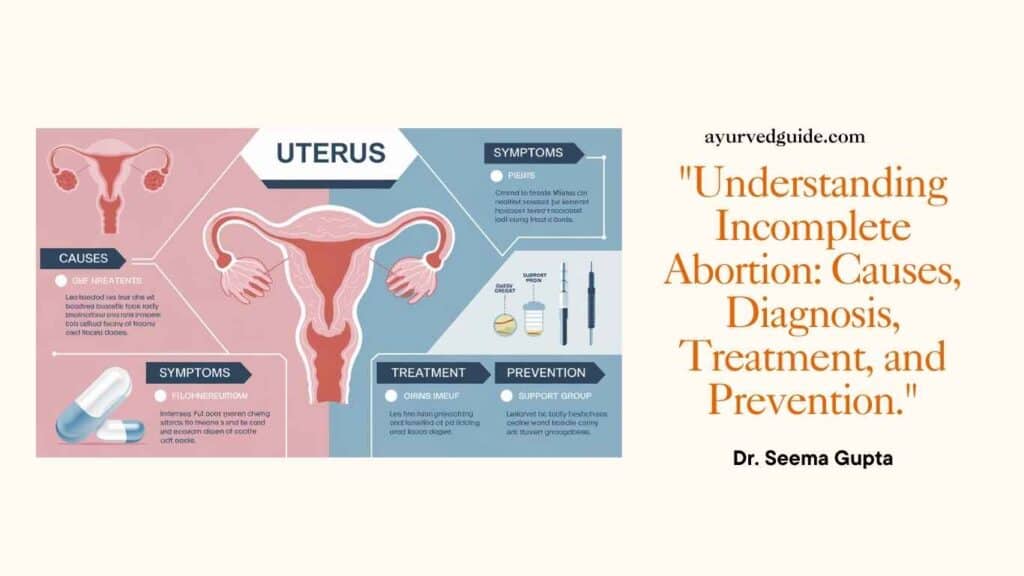
The silent nature of incomplete abortion may mask its severity, leaving many individuals unaware of the possible risks hiding beneath the surface. The results can be serious, ranging from severe bleeding to infections that can be fatal. However, with appropriate understanding and timely management, these dangers can be significantly reduced.
In this article, we will discuss incomplete abortion definition, signs of incomplete abortion, complete vs incomplete abortion, causes of incomplete abortion, diagnosis of incomplete abortion, ultrasound, and many more.
As we explore this important topic, we will discover the essential elements of incomplete abortion, from the starting point to long-term recovery.
Incomplete Abortion definition
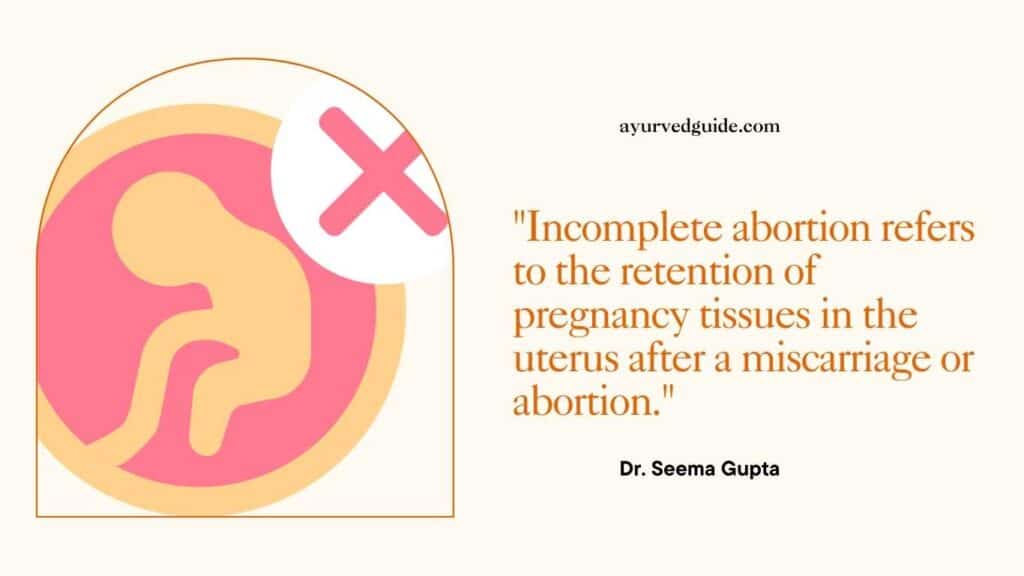
Incomplete abortion means that the tissues related to pregnancy (conception product) that were in the uterus did not come out completely. In medical language, it is called “retained products of conception” (RPOC). The most accurate way to identify it is ultrasound, usually done on the 14th day of taking the MTP kit.
Apart from this, a blood test (serum beta hCG) can also be done around the 18th day, which shows whether the abortion has happened completely or not.
This condition can occur naturally (spontaneous abortion) or following a medical or surgical abortion procedure. The retained tissue can lead to various complications if not properly addressed.
Causes of incomplete abortion:

- Spontaneous miscarriage
- Unsuccessful medical abortion
- Incomplete surgical abortion
- Molar pregnancy
- Ectopic pregnancy complications
| Cause | Description |
|---|---|
| Spontaneous miscarriage | Natural expulsion of pregnancy tissue, but some remains |
| Unsuccessful medical abortion | Medication fails to completely remove all pregnancy tissue |
| Incomplete surgical abortion | The surgical procedure leaves some tissue behind |
| Molar pregnancy | Abnormal growth of placental tissue |
| Ectopic pregnancy complications | Pregnancy outside the uterus ruptures, leaving tissue |
Other Causes
- Use of wrong medicines: Consumption of local brand or expired tablets.
- Taking medicine at the wrong time: Not using the MTP kit correctly and at the right time.
- Incomplete dose of drugs: If you have not taken all the tablets in the kit.
- Wrong estimation of the duration of pregnancy: Taking medicine in the early or late days of pregnancy can also lead to incomplete abortion.
Symptoms and signs – Signs of Incomplete Abortion

Recognizing the symptoms and signs of incomplete abortion is crucial for timely intervention and treatment. Common indicators include:
- Low or irregular bleeding:
If bleeding is not happening properly or blood clots are not coming out, then it can be a sign of incomplete abortion. - High fever:
If your body temperature exceeds 101°F, then it can be a symptom of infection or incomplete abortion. - Pain in the lower abdomen:
Feeling continuous severe pain in the lower abdomen, which does not subside even after taking painkillers, is a major sign of incomplete abortion. - Increased bleeding:
If the bleeding is too much even after 5 to 7 days and large blood clots are coming in, then it is a matter of concern. - Abnormal discharge or odor:
If there is a thick white or yellow pus-like discharge from the vagina, or a foul smell (like dead mice or fish), it can be a clear sign of incomplete abortion. - Bleeding cycles of stopping and restarting:
If the bleeding had stopped and then started again after a few days, it is also a sign that there may still be pregnancy tissues left in the uterus. - Persistent pregnancy symptoms:
If the symptoms of pregnancy are still felt, it may be due to incomplete abortion. It’s important to note that symptoms may vary in intensity and duration among individuals.
Risk factors
Several factors can increase the likelihood of experiencing an incomplete abortion:
- Advanced maternal age (over 35)
- History of previous miscarriages
- Certain medical conditions (e.g., thyroid disorders, uncontrolled diabetes)
- Uterine abnormalities
- Smoking, alcohol consumption, or drug use during pregnancy
- Exposure to environmental toxins
- Nutritional deficiencies
- Hormonal imbalances
- Genetic factors
Complications of Incomplete Abortion
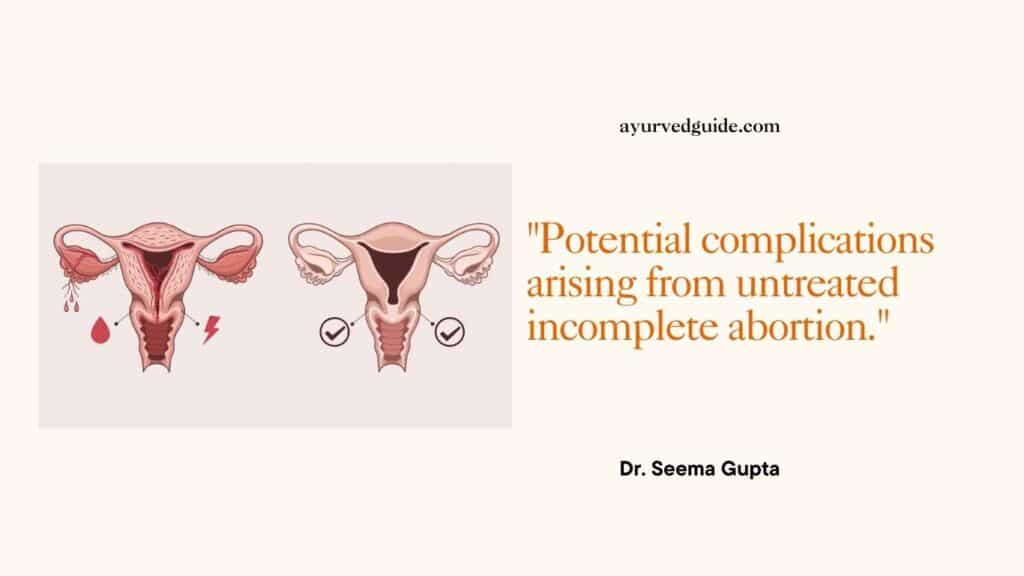
- Infection: The tissues left in the uterus can cause infection.
- Prolonged bleeding: This can cause weakness and anemia (lack of blood).
- Severe pain and discomfort: Constant pain can affect your daily life.
- Impact on reproductive health: Not getting timely treatment can lead to problems related to pregnancy in the future.
Complete vs Incomplete Abortion
Understanding the distinction between incomplete and complete abortion is essential for proper management and treatment.
| Aspect | Incomplete Abortion | Complete Abortion |
|---|---|---|
| Retained tissue | Some pregnancy tissue remains in the uterus | All pregnancy tissue expelled |
| Bleeding | Prolonged and potentially heavy | Gradually decreases and stops |
| Pain | May persist or intensify | Subsidies over time |
| Uterine size | May remain enlarged | Returns to pre-pregnancy size |
| Need for intervention | Often requires medical or surgical treatment | Usually doesn’t require additional intervention |
| Risk of complications | Higher risk of infection and hemorrhage | Lower risk of complications |
When all pregnancy tissue is removed from the uterus, a complete abortion takes place, causing symptoms to subside and the woman to return to her non-pregnant state. On the other hand, to remove residual tissue and avoid any problems, incomplete abortions need to be managed further.
After going over the basics of incomplete abortion, such as its definition, causes, symptoms, and distinctions from complete abortion, we can now talk about the important parts of diagnosis and evaluation.
Read more, Experiencing No Bleeding After MTP Kit? Discover the Common Reasons and Next Steps!
Diagnosis for Incomplete Abortion
Physical examination
The initial step in diagnosing an incomplete abortion involves a thorough physical examination. During this process, doctors assess various symptoms and signs that may indicate an incomplete abortion.
Common symptoms include:
- Vaginal bleeding
- Abdominal pain or cramping
- Passage of tissue or clots
- Fever (in some cases)
Pelvic Examination
A pelvic examination is typically performed to evaluate the cervix and uterus. The doctor will check for:
- Cervical dilation
- Presence of tissue in the cervical os
- Uterine size and consistency
- Tenderness or pain during examination
Incomplete Abortion Ultrasound

Ultrasound imaging plays a crucial role in confirming the diagnosis of an incomplete abortion. This non-invasive procedure provides valuable information about the contents of the uterus and helps differentiate between various types of pregnancy complications.
Key aspects assessed during ultrasound include:
- Presence of retained products of conception – RPOC
- Endometrial thickness
- Gestational sac (if still present)
- Fetal cardiac activity (if applicable)
| Ultrasound Findings | Interpretation |
|---|---|
| Empty uterus with thin endometrium | Complete abortion |
| Heterogeneous material in the uterus | Incomplete abortion |
| Gestational sac without a fetal pole | Early pregnancy loss |
| Thickened endometrium (>15mm) | Possible retained products |
Blood Tests for Incomplete Abortion
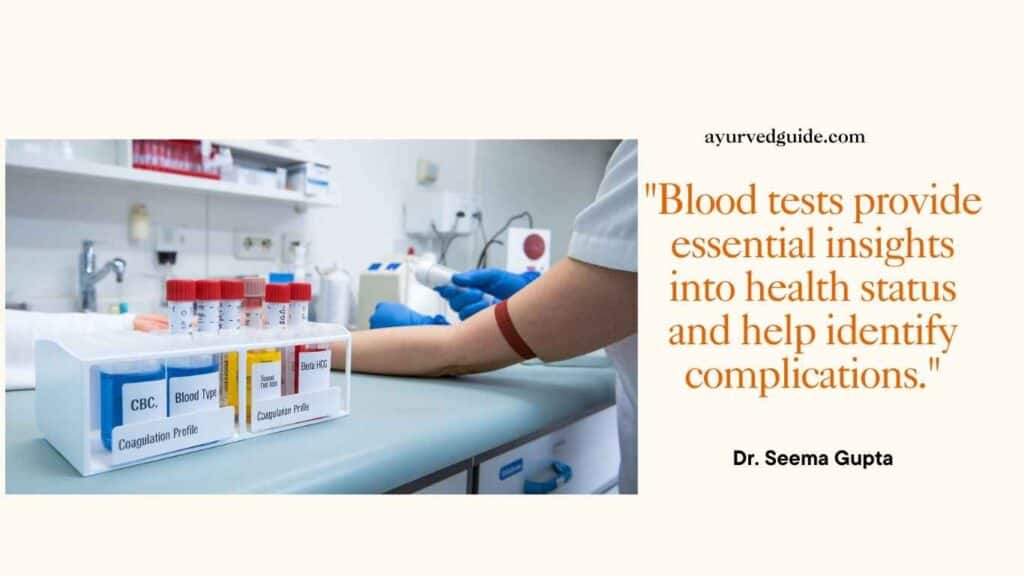
Blood tests are necessary for assessing the overall health status of the patient and identifying potential complications. Common tests include:
- Complete blood count (CBC): To evaluate hemoglobin levels and detect anemia
- Blood type and Rh factor: To determine if Rh immunoglobulin is needed
- Beta-hCG levels: To confirm pregnancy status and monitor its progression
- Coagulation profile: To assess blood clotting function
After discussing the diagnostic procedure, we may now examine the different approaches to treating incomplete abortions.
Treatment of Incomplete Abortion
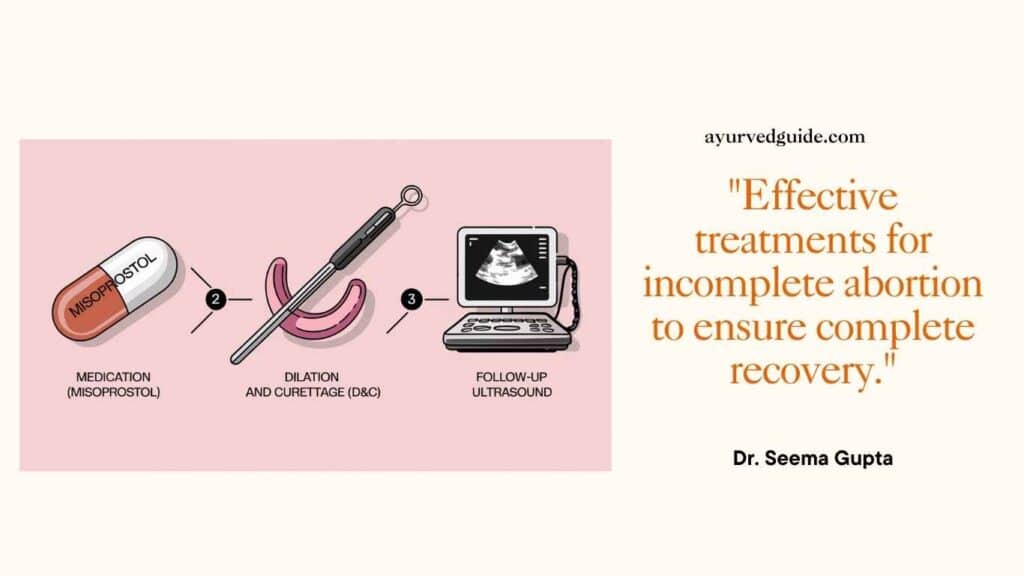
Expectant Management
A non-invasive method of managing incomplete abortions is called expectant management, which lets the body finish the procedure on its own. Patients with few symptoms and no indications of infection can use this approach.
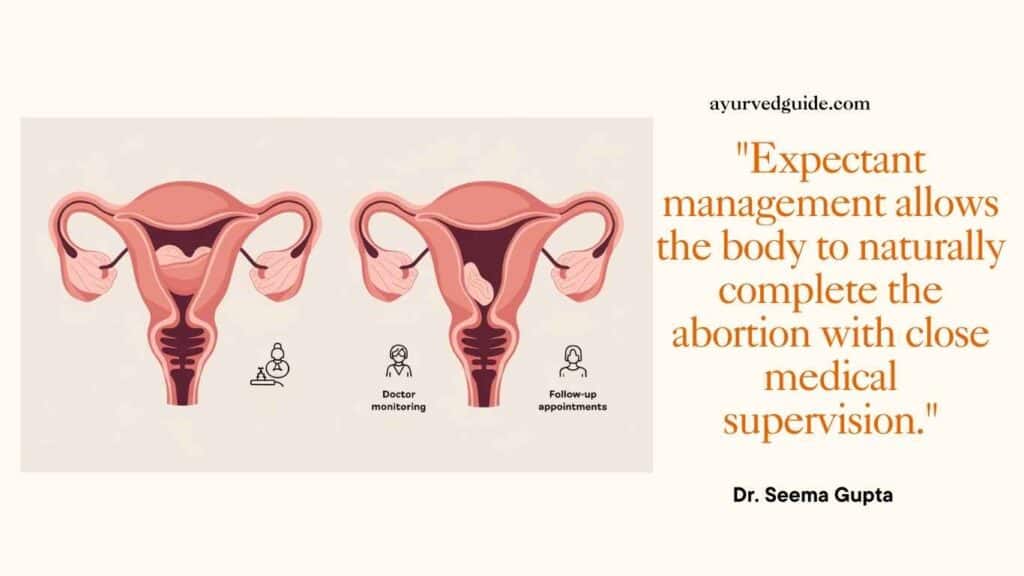
Key points of expectant management:
- Close monitoring by doctors
- Regular follow-ups to assess progress
- Potential for longer recovery time
- Lower risk of complications compared to invasive procedures
| Pros | Cons |
|---|---|
| Non-invasive | Longer duration |
| Lower cost | Unpredictable outcome |
| Minimal medical intervention | Potential for incomplete resolution |
Medical Intervention
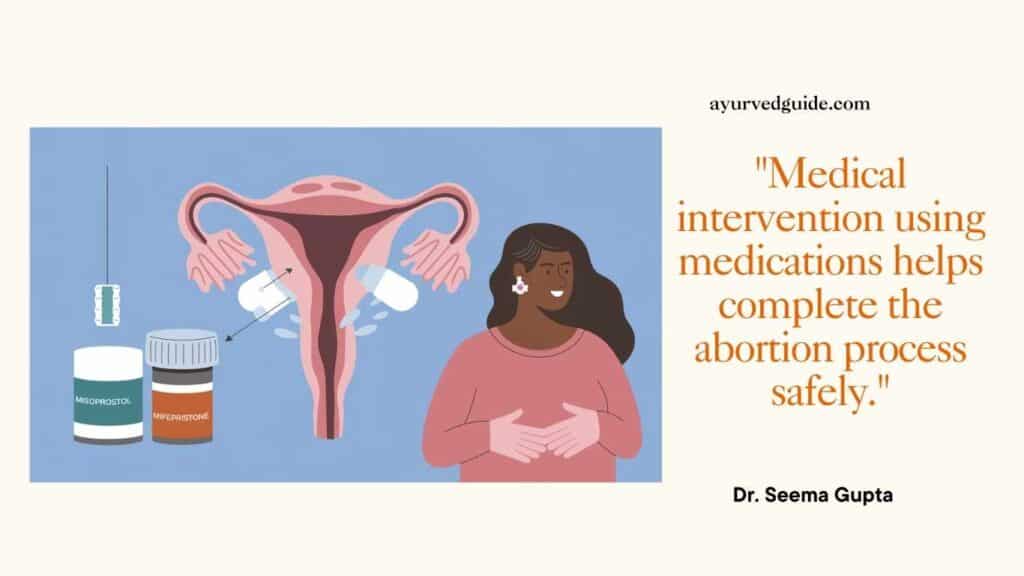
Medication is used in medical management to help complete the abortion procedure. Because of its efficacy and low level of invasiveness, this approach is frequently used.
Common medications used:
- Treatment of incomplete abortion with misoprostol
- Mifepristone (in combination with misoprostol)
- Oxytocin (in certain cases)
These medications help stimulate uterine contractions, promoting the expulsion of residual tissue. The choice of medication depends on factors such as gestational age and patient health status.
Surgical Procedures
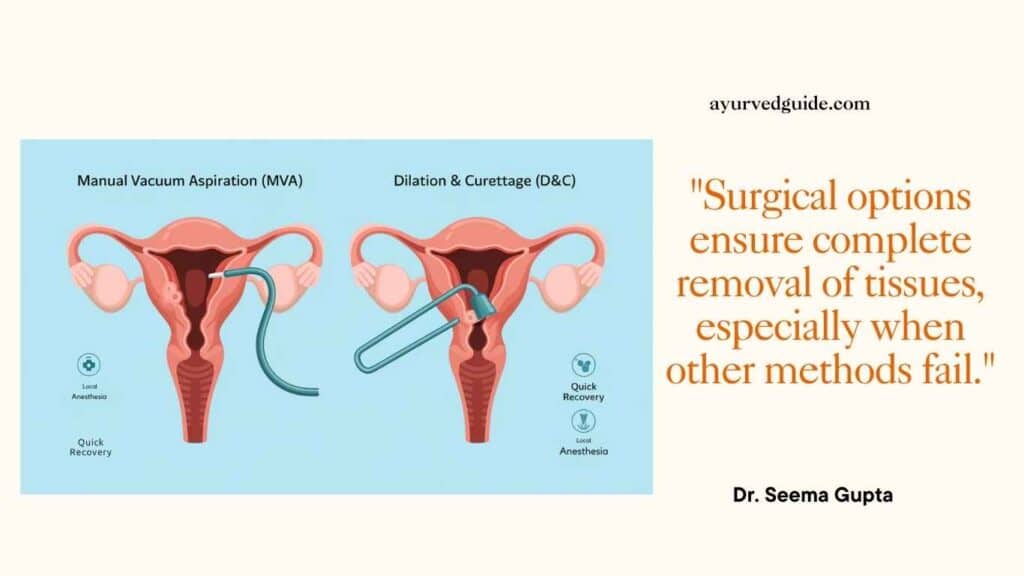
In situations where medicinal or expectant therapy is unsuitable or unsuccessful, surgery may be required. The following surgical techniques are most frequently used for incomplete abortions:
- Manual Vacuum Aspiration (MVA)
- Dilation and Curettage (D&C)
| Procedure | Description | Advantages |
|---|---|---|
| MVA | Uses suction to remove remaining tissue | Quick, less invasive, can be performed in outpatient settings |
| D&C | Involves dilating the cervix and curating the uterine lining | Thorough removal of tissue, useful for later gestational ages |
Surgical procedures are typically performed under local or general anesthesia, depending on the patient’s condition and preferences.
Follow-up Care

For all treatment methods to guarantee full recovery and prevent problems, proper follow-up care is essential. Important facets of follow-up care consist of:
- Keeping an eye out for any indications of infection or ongoing bleeding
- Using blood testing or ultrasonography to determine whether the abortion was complete
- Offering counseling and emotional support
- Talking about potential alternatives for contraception
Patients must be informed about possible warning indicators that call for prompt medical intervention, like:
- Severe bleeding (soaking over two pads in a single hour for two hours in a row)
- Excruciating stomach pain
- Chills or fever
- Odorous vaginal discharge
Frequent follow-up visits enable medical professionals to address any issues and guarantee appropriate recovery. Depending on the specific patient’s circumstances and the treatment approach selected, the frequency and length of follow-up care may change.
More varied and individualized treatment options are now available due to improvements in medical technology and a greater understanding of incomplete abortion.
Several parameters, such as clinical presentation, gestational age, and patient wish, influence the therapy decision. To help patients make the best decisions and guarantee the best results, healthcare providers play a crucial role.
Potential Complications
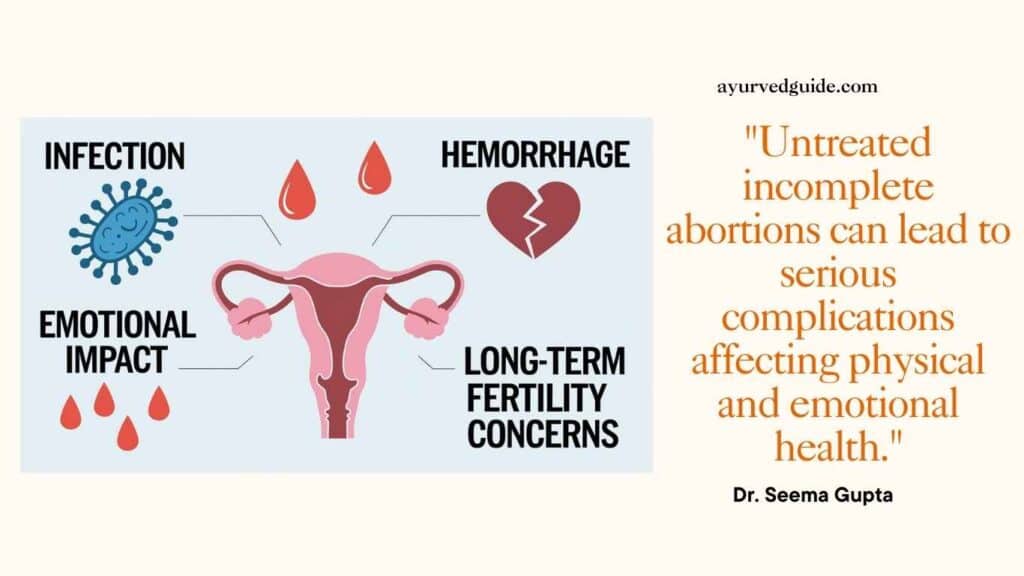
Infection
After an incomplete abortion, infection is a serious risk. Numerous problems may arise as a result of bacteria growing in the uterus’s retained tissue. Typical indications of infection include:
- Fever (heat above 100.4°F, or 38°C)
- Odorous vaginal discharge
- Severe cramping or discomfort in the abdomen
- Sweats and chills
To stop the infection from spreading and possibly leading to more serious problems like sepsis, prompt medical intervention is essential.
Hemorrhage
Hemorrhage, or excessive bleeding, is another harmful complication of an incomplete abortion. It may happen because of:
- Placental tissue that was retained
- The inability of the uterus to contract normally (known as uterine atony)
- Damage to the uterus or cervix
| Severity | Blood Loss | Signs and Symptoms |
|---|---|---|
| Mild | < 500 mL | Slight dizziness, weakness |
| Moderate | 500-1000 mL | Tachycardia, hypotension, pallor |
| Severe | > 1000 mL | Shock, organ failure, loss of consciousness |
Immediate medical intervention is essential to control bleeding and prevent further complications.
Emotional and Psychological Effects
An incomplete abortion can have a significant and lasting psychological impact. Typical emotional reactions consist of:
- Sadness and grief
- Depression and anxiety
- Self-blame or guilt
- PTSD (post-traumatic stress disorder)
To properly treat these emotional effects, which may last long after the physical recovery, professional counseling or therapy may be necessary.
Long-term Fertility Concerns
Even though the majority of women who have an incomplete abortion go on to have healthy pregnancies, there may be long-term fertility issues:
- Scar tissue that forms in the uterus as a result of Asherman’s syndrome may cause problems with subsequent pregnancies.
- Cervical incompetence: Cervical weakening that may result in future pregnancies ending prematurely.
- A higher chance of an ectopic pregnancy due to possible fallopian tube damage.
Monitoring and treating these possible long-term impacts requires routine follow-up treatment and thorough evaluations of reproductive health.
Prevention and Risk Reduction
Proper Prenatal Care

The chance of an incomplete abortion can be significantly decreased with proper prenatal care. Frequent examinations with medical professionals enable the early identification and treatment of such issues. Usually, these visits consist of:
- Regular ultrasounds to track the development of the fetus
- Blood tests to check for genetic diseases and infections
- Monitoring of blood pressure
- Urine testing to detect preeclampsia and urinary tract infections
Attending all appointments on time and following your doctor’s advice are crucial. A thorough prenatal care plan can considerably decrease the risk of incomplete abortion and other pregnancy-related issues.
| Prenatal Care Component | Frequency | Benefits |
|---|---|---|
| Check-ups | Monthly (1st-2nd trimester), Bi-weekly (3rd trimester) | Early detection of complications |
| Ultrasounds | At least 2-3 times during pregnancy | Monitor fetal growth and development |
| Blood tests | Once per trimester | Screen for infections and genetic disorders |
| Nutrition counseling | Throughout pregnancy | Ensure proper fetal development |
Managing Underlying Health Conditions
The chance of an incomplete abortion may be increased by some pre-existing medical problems. Reducing this risk requires careful management of certain conditions:
- Diabetes: Make sure your blood sugar stays within the ideal range.
- Thyroid conditions: Ensure you take the right prescription and get checked frequently.
- Work closely with experts to control the symptoms of autoimmune disorders.
- Hypertension: Manage blood pressure with medication and lifestyle modifications.
Notifying medical professionals about any current illnesses and prescription drugs is essential. This ensures close monitoring of the pregnancy and adjustments to treatment plans as needed.
Read more, The Unwanted Kit: Uses, Side Effects, and Price – What You Need to Know Before Using!
Lifestyle Modifications
Adopting a healthy lifestyle can dramatically minimize the risk of incomplete abortion.
- Maintain a balanced diet, rich in important nutrients.
- Stay hydrated by drinking lots of water.
- Take part in moderate, pregnancy-safe exercise as advised by your healthcare provider.
- Avoid hazardous substances like alcohol, tobacco, and illegal narcotics.
- Manage stress using relaxation techniques and proper rest.
These lifestyle changes not only lower the likelihood of an incomplete abortion but also improve maternal and fetal health.
Now that we’ve discussed prevention and risk reduction tactics, it’s crucial to recognize that, while these efforts can greatly reduce the possibility of an incomplete abortion, they cannot completely remove the danger. In the following section, we’ll examine the critical features of assistance and recovery for those who have…
Support and Recovery
Physical Healing Process
The physical healing process following an incomplete abortion is essential for the patient’s recovery. It usually includes numerous stages:
Initial healing time (1-2 weeks):
- Rest and minimum physical activity.
- Monitor for evidence of infection or effects.
- Managing pain and suffering.
Gradual return to regular activity (2-4 weeks):
- Slowly increasing physical exertion.
- Continuous monitoring of bleeding and pain.
Full healing (4-6 weeks):
- Return to normal daily habits.
- Resuming physical intimacy activity (as advised by a healthcare provider).
| Stage | Duration | Key Focus |
|---|---|---|
| Initial recovery | 1-2 weeks | Rest, monitoring, pain management |
| Gradual return | 2-4 weeks | Increasing activity continued monitoring |
| Full recovery | 4-6 weeks | Normal routines, sexual activity resumption |
Emotional Support Resources

Emotional recovery is as essential as physical healing. There are a variety of options available to help patients:
- Professional Counseling Services
- Support groups (online or in-person)
- Mental health helplines
- Self-help books and literature
- Online forums and communities
It is important to understand that emotional recovery is a personal process, and individuals may require varying sorts and levels of assistance.
Follow-Up Appointments
Follow-up appointments are essential for tracking progress and addressing any issues. These usually include:
Initial follow-up (1-2 weeks after the procedure):
- Physical examination
- Ultrasound to ensure full evacuation
- Discuss any symptoms or concerns
Secondary follow-up (4-6 weeks after the procedure):
- Assessment of physical and emotional recovery
- Discussion of future fertility and contraceptive alternatives
Depending on the individual’s circumstances and healing progress, healthcare practitioners may prescribe more appointments.
Future Pregnancy Considerations

After an incomplete abortion, patients frequently have concerns about future pregnancies. Key considerations include:
Timing of the next pregnancy:
- Most healthcare experts support waiting for a whole menstrual cycle before attempting to conceive.
- Some recommend waiting 3-6 months for optimal physical and mental recuperation.
Fertility Impact:
- In general, an incomplete abortion has little long-term effect on fertility.
- However, problems such as infection may influence future reproductive health.
Risk Factors:
- Identifying and treating any underlying problems that could have contributed to the partial abortion.
- Discussing lifestyle modifications or medical measures to lower future risks.
Prenatal Care:
- Emphasizing the significance of early and consistent prenatal care in future pregnancies.
- Consider further monitoring or help for subsequent pregnancies.
With the proper care and support, most people who have had an incomplete abortion can go on to have healthy pregnancies in the future. However, it is essential to discuss any concerns with a healthcare doctor and create a tailored strategy for future reproductive health.
Conclusion
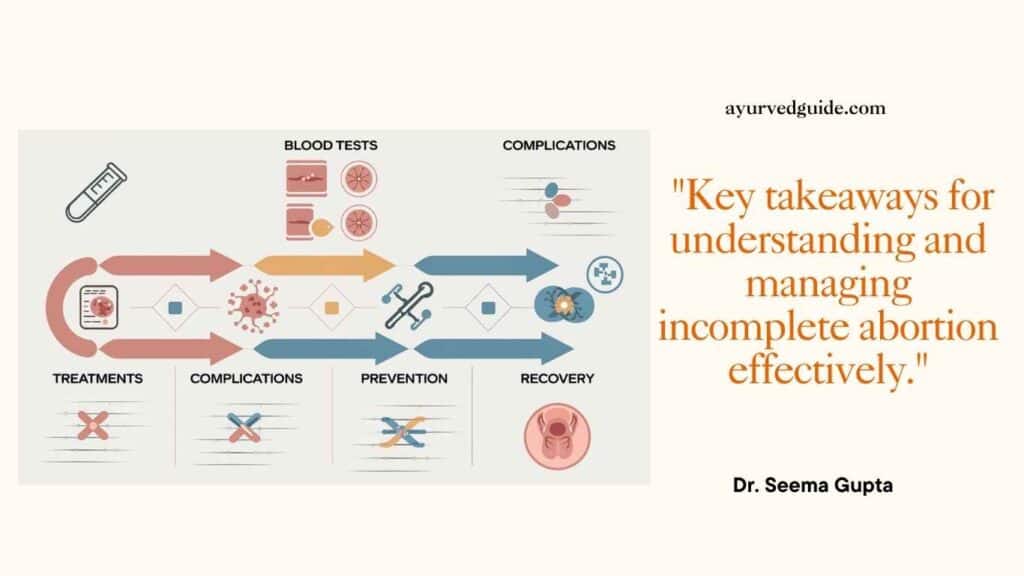
Incomplete abortion remains a major concern in reproductive health, necessitating early detection and effective therapy. Early diagnosis through clinical examination and ultrasound imaging is critical for selecting the best treatment strategy.
Medical therapy with misoprostol or surgical techniques such as vacuum aspiration are viable solutions that are tailored to each patient’s unique situation.
Prioritizing preventative methods, such as access to safe abortion services and adequate contraceptive care, is critical to minimizing the number of incomplete abortions.
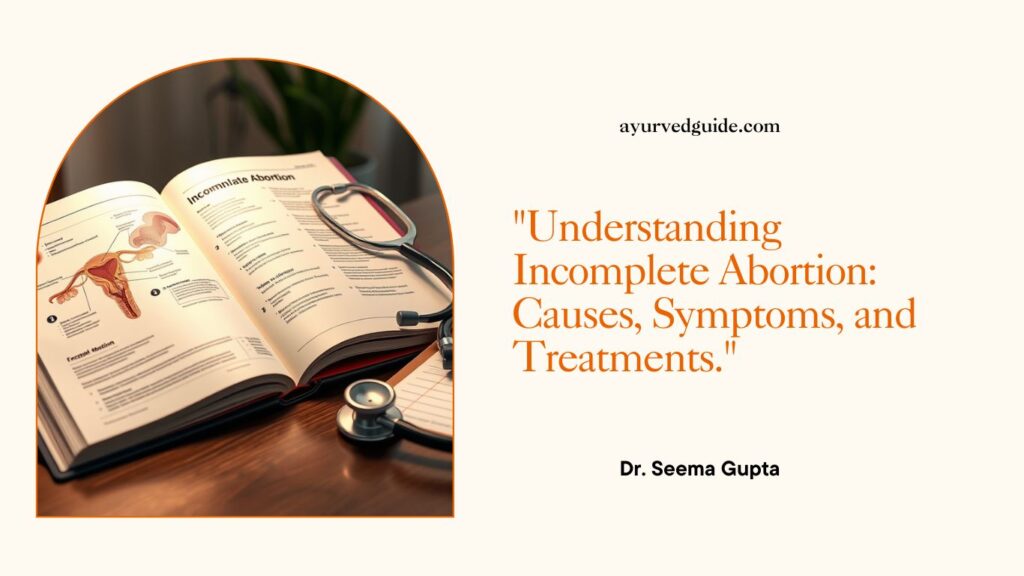
Doctors play an important role in providing compassionate treatment and direction during the healing process. Healthcare systems can improve impacted individuals’ overall well-being and outcomes by treating both the physical and emotional components of incomplete abortion.
I hope you will like this information.
FAQ’S
What is an incomplete abortion?
A complete abortion is characterized by bleeding and the clinical appearance of an open cervical os, meaning that either none of the products of conception have been expelled from the uterus or the products that have left do not match the expected length of pregnancy. Abdominal pain and vaginal bleeding are typical symptoms.
When is the best time to abort?
It is low-risk, easy, and safe if done before 12 weeks of pregnancy. The abortion process could be more difficult if it has been more than 12 weeks since your last menstruation.
What happens if the abortion pill fails?
These choices could consist of:
- A second round of medication: To finish the abortion, it can be necessary at times to take additional abortion pills.
- In-clinic abortion: To guarantee that the pregnancy is terminated, an in-clinic abortion procedure can be required if the drug-induced abortion proves ineffective.
Is abortion painful at 1 month?
It can be difficult and uncomfortable to have a medical abortion during the first month of pregnancy. In addition to some bleeding or spotting, women may have discomfort spells for a few days.
How to know if an abortion is complete or incomplete?
Vaginal bleeding, cervical dilatation, cramping (contractions), and incomplete evacuation of the products of conception are all signs of an incomplete abortion. When a woman has an incomplete abortion, she often reports vaginal bleeding and the passage of clots or tissue fragments.
What if I am 2 months pregnant and I don’t want the baby?
Although there may be drawbacks, many women find that if they are two months pregnant and do not want the baby, abortion is the best course of action.
- Adoption: Adoption may be the greatest option for women who know they are incapable of serving as parents but still wish to provide their child with a loving home.
Can abortion cause infertility?
Elective abortions rarely result in problems with future pregnancies or fertility.
Is abortion safe?
In general, abortions are quite safe. But problems are possible with any medical procedure. The longer a pregnancy lasts, the higher the danger.
How does abortion bleeding look like?
The color of clots ranges from red to dark purple. After the procedure, only use sanitary pads—not tampons—to stop bleeding. For a few days, you can get cramping. Four to six days following the procedure, some women have an episode of severe bleeding and discomfort.
What is the process of abortion?
To start a medication abortion, you need to take a pill called mifepristone. 48 hours later, you will take another dose of misoprostol at home. Most females have severe cramps and bleeding after taking the second dose of the pill, and they pass the pregnancy within the next few hours.
What are the side effects after an abortion?
Cramps and bleeding can begin one to four hours after the second dose. The next few hours are marked by severe cramps and blood clots. Chills or a low-grade fever that appears one day after taking the second dose. Some females experience diarrhea, nausea, or dizziness along with fatigue.
What is the recovery time for an abortion?
For up to two weeks following a surgical abortion, you can experience cramping and mild bleeding. After the procedure, most patients can resume their regular activities within a day or two. You can estimate how long you will recover from the medical situation. However, everyone heals at a different rate.
